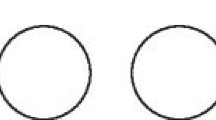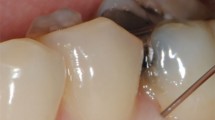Abstract
Design Randomised clinical trial
Study population The present study evaluated patients of different genders aged between 18-65 years old. The study design and the language of the consent form were approved by the Ethics Committee at Tehran University of Medical Sciences (TUMS) (approval code: IR.TUMS.REC.1394.1906). The study was registered in the Iranian Registry of Clinical Trials.
Data Analysis The evaluation was performed using the Heft-Parker Visual Analog Scale (HP VAS) and complemented with the electrical pulp test accuracy to determine the success of anaesthesia
Results In this study, the success rate was 93.8% (95% CI 79.19-99.23) for mental/incisive nerve block (MINB), and 81.2% (95% CI 63.56-92.79) for inferior alveolar nerve block (IANB). The difference was not significant (p = 0.26). An interesting result was the combination of both techniques was 100% successful in the failed cases (2 in MINB group; 6 in IANB group).
Conclusions In conclusion, MINB using 4% Articaine showed a similar success rate as IANB using 4% Articaine in local anaesthesia for mandibular premolars with irreversible pulpitis. The beginning of anaesthesia was faster for MINB, and the injection was painless. The post-injection pain for MINB was higher than for IANB. Both techniques showed similar efficacy.
Similar content being viewed by others
A Commentary on
Ghabraei S, Shubbar A, Nekoofar M H, Nosrat A.
Anaesthetic efficacy of mental/incisive nerve block compared to inferior alveolar nerve block using 4% articaine in mandibular premolars with symptomatic irreversible pulpitis: a randomized clinical trial. Clin Oral Investig 2019; 23: 839-845. DOI: 10.1007/s00784-018-2500-4.

GRADE rating
Commentary
This study aimed to compare the success rate, injection pain, and post-injection pain of mental/incisive nerve blocks (MINB) when compared to lower alveolar nerve block (IANB) using 4% Articaine for painful mandibular premolars with symptomatic irreversible pulpitis. The accuracy of the electrical pulp test (EPT) in determining pulpal anaesthesia was also examined.
This study begins with a citation on the effectiveness of IANB blocks not being 100%. The data presented by the authors citing the systematic review presented by Kung et al.,1 described a comparison between two local anaesthetics (Articaine and Lidocaine) for irreversible pulpitis. However, the study by Ghabraei, complements the information in the first paragraph, adding the possible need for anaesthetic complementation using other techniques.

At no point do the authors consider anatomy as a variable .This is an essential step, although difficult, since there is a possibility of IANB fiber exchange with other sensory nerves in the head and neck area.2 It can increase the risk of bias in studies evaluating the effectiveness of local anaesthetics for IANB blocks.
The technique used in the study is well documented, although the authors worked with a wide age range for the patients (18-65 years) which gives a possibility of bias in the study as the difference between the pain threshold for men and women has been well known for a long time.3 Although the authors performed a statistical test for the sample, we believe these differences were not taken into account as these tests are based on similar studies previously published. And, to date, we have not observed studies on local anaesthetics that take into account the difference between the patient's age and gender in the same study. In a randomised clinical trial evaluating local anaesthesia these variables may be very important.
Another issue that leads to doubt about the study is the infusion of another anaesthetic, in this case, Lidocaine, in patients with moderate to severe pain, using a different technique (intra-osseous), which makes little sense, since the study evaluates 4% Articaine. The choice of Lidocaine for this purpose was unclear in the text of the study. According to the results, it was used and described as a 'combination of both techniques.'
Within the results, the authors described the success rate for anaesthetic techniques as follows, 'the success rates varied from 94.4% (MINB in 1st premolars) to 78.9% (IANB in 2nd premolars). The combination of both techniques was 100% successful in the failed cases (2 in MINB group; 6 in IANB group).' If there is a 100% chance of success in combining techniques, the authors should have evaluated this approach. Another issue is the use of lidocaine as a 'combination' anaesthetic - they could have possibly used Articaine for this purpose, since, as discussed earlier, there is fiber exchange with other sensory nerves. The difference is not in the substance used to promote local anaesthesia.
The present study would not lose value without the presence of the EPT, which proved to be just additional data reported by the authors, but it was not possible to observe relevance in its use since a pain scale was used. A Visual Analog Scale (VAS) would be sufficient for the presentation of a good study. It is possible to understand the authors' concern with the data because the VAS is a subjective analysis, which may differ according to the patient.
In general, the study presented by Ghabraei, is a useful contribution to the literature. However, like most clinical studies, it has limitations, as described above.
References
Kung J, McDonagh M, Sedgley CM. Does articaine provide an advantage over lidocaine in patients with symptomatic irreversible pulpitis? A systematic review and meta-analysis. J Endod 2015; 41: 1784-1794.
Gomes L T, de Almeida Barros Mourão C F, Braga C L, de Almeida L F D, de Mello-Machado R C, Calasans-Maia M D. Anatomic evaluation of the incisive canal with cone beam computed tomography and its relevance to surgical procedures in the mental region: a retrospective study in a Brazilian population. Oral Maxillofac Surg 2018; 22: 379-384.
Racine M, Tousignant-Laflamme Y, Kloda L A, Dion D, Dupuis G, Choinière M. A systematic literature review of 10 years of research on sex/gender and pain perception - part 2: do biopsychosocial factors alter pain sensitivity differently in women and men? Pain 2012; 153: 619-635.
Author information
Authors and Affiliations
Rights and permissions
About this article
Cite this article
de Almeida Barros Mourão, C., Javid, K. How should we anaesthetise painful mandibular premolars?. Evid Based Dent 21, 20–21 (2020). https://doi.org/10.1038/s41432-020-0080-z
Published:
Issue Date:
DOI: https://doi.org/10.1038/s41432-020-0080-z



